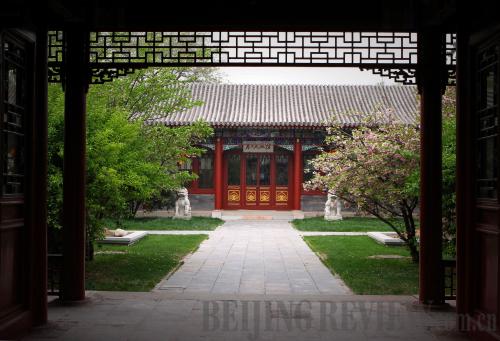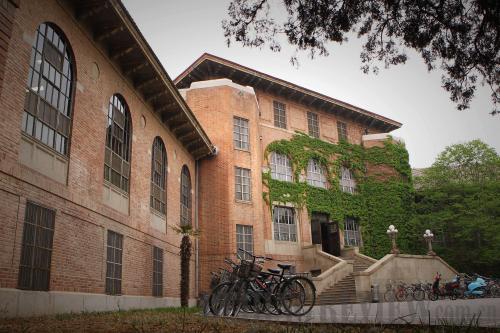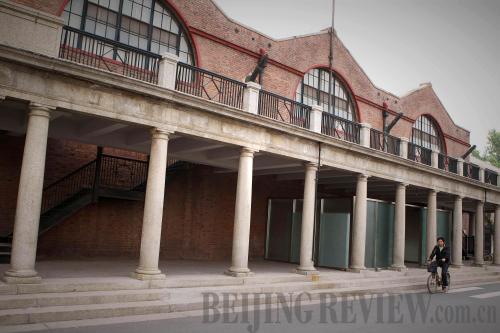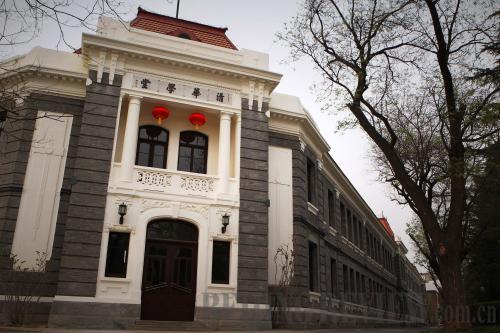|
 |
 |
| BIRTHPLACE: The first office building of Tsinghua Xuetang, today's Tsinghua University (XING GUANGLI) |
HOUSE OF KNOWLEDGE: The first library at Tsinghua University (XING GUANGLI) |
 |
 |
| CROSS-CULURE SYMBOL: The gymnasium is one of four Western-style landmark buildings at Tsinghua University (XING GUANGLI) |
LANDMARK: Tsinghua Xuetang, a German-style structure, is the first teaching building of Tsinghua University (XING GUANGLI) |
Recently on January 14 at the annual State Supreme Science and Technology Award Ceremony held in Beijing, 19 Tsinghua University's research achievements were granted the 2010 State Science and Technology Awards. Tsinghua University ranked first in terms of the number of award-winning achievements among Chinese higher-learning institutions.
So far, Tsinghua University has won a total of 419 State Science and Technology Awards, including 44 State Natural Science Awards, 120 State Technological Invention Awards, and 255 State Scientific and Technological Progress Awards.
From 1985 to November 2010, Tsinghua University was authorized 11,000 patents. It has also intensified efforts to put the achievements into commercial use. Between 2009 and 2010 alone, more than 70 patent licensing and transfer contracts, each worth between $15,000 and $150,000, were signed with businesses. It has also partnered with more than 190 large enterprises at home and abroad and carried out hundreds of joint research and development projects.
Social contribution
Tsinghua University produces more than scientists and engineers.
Many faculty members of Tsinghua University were renowned scholars in social sciences. Wang Guowei, Liang Qichao, Chen Yinque and Zhao Yuanren, known as the "Four Tutors" in the Institute of Chinese Classics in the 1920s, had profound impacts on social and cultural development in China.
Some Tsinghua graduates in the field of humanities also have become famous scholars in their respective fields. Among them is renowned Peking University professor Ji Xianlin, who was China's leading scholar in oriental studies.
The university is also the alma mater of more than 280 government officials at or above the ministerial level after 1949, including nine incumbent and former top state leaders such as President Hu Jintao, Chairman of the Standing Committee of the National People's Congress Wu Bangguo, Vice President Xi Jinping and former Premier Zhu Rongji.
Tsinghua students have made historic impacts in China's social development.
On May 4, 1919, student demonstrations in Beijing sparked an anti-imperialist, cultural and political movement. The May 4 Movement is a milestone in China's modern history. On May 6, Tsinghua students boycotted classes, and actively participated in the movement.
From then on, Tsinghua students came onto the political stage. In 1935, Japan instigated several provinces in north China to declare "autonomy." Jiang Nanxiang, then a junior student in Tsinghua University who served as the university's president in 1952-66 and minister of education, wrote a famous open letter rallying people against the "autonomy." He said in the letter, "North China is so big, but it has not room for a peaceful desk."
During the War of Resistance Against Japanese Aggression in 1937-45, Tsinghua students made various contributions.
After the inauguration of the reform and opening-up policy in China in 1978, China embarked on rapid economic development. Tsinghua student Wang Wenyi put forward a slogan "From Myself, and From Now," calling on students to study hard and contribute to the country's construction. The slogan was later published in official newspapers, and influenced all society.
Now, Tsinghua students continue the tradition of contributing to the society. After the Wenchuan earthquake in Sichuan Province in 2008, thousands of students donated blood. During the Beijing Olympic Games in 2008, more than 3,000 Tsinghua students served as volunteers.
Economic influence
Tsinghua University's academic strength and social contribution is no surprise. Recently, people were impressed with its influence in the economic field disclosed by China Economic Weekly.
The report said of every 20 yuan ($3) in the Chinese yuan-denominated A-share market, 1 yuan ($0.15) was in the hand of the Tsinghua legion, referring to executives who have either taught or studied at Tsinghua University. All together, the Tsinghua legion-related companies have a combined market value of 1.4 trillion yuan ($216 billion).
| 